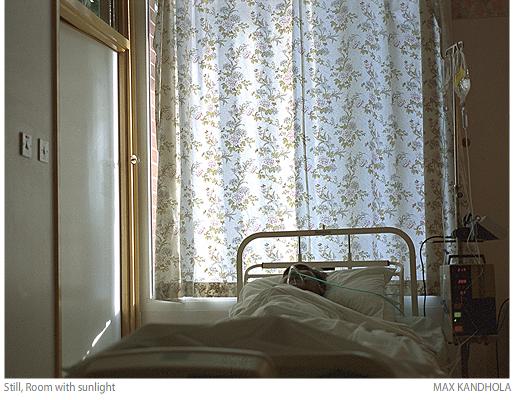
Photoink Hyundai MGF Building, ground floor. 1 Jhandewalan, Faiz Road 110005 New Delhi Inde
In the mid-1990s Max Kandhola embarked upon a personal odyssey to map his family heritage. Illustration of Life, the first part of the trilogy that began in 1996, is a poignant and painful document of his father’s struggle with cancer that led to his death. In our unpredictable world there is one certainty upon which we can always rely; yet death, when it comes, is never easy. In this extraordinary body of work, Kandhola photographed his father in the final stages of a terminal illness. His intensely personal and honest images confront us with the intimate and often painful reality of death.Following his fathers diagnosis with cancer, Kandhola spent two years meticulously collecting and photographing fragments and debris from his chemotherapy treatment: samples of blood, urine, hair and ultimately even the ash from his cremation. These serenely beautiful abstract images form a counterpoint to the haunting final photographs made at his father’s bedside. Whilst photographing over a period of six hours, Kandhola captured the brief moment just before and after his father’s death.
In Mark Sealy’s essay for the book (Illustration of Life) he writes, “Kandhola invites us to contemplate life, through his experience of death in much the same way as Bill Viola does in his celebrated work, Nantes Triptych. Such work asks a very simple question: Can we reconcile the fact that death is indeed part of life? These photographs, therefore, have a key role to play in the act of reconciliation and the process of change. In such an intensive emotional situation it’s actually a profound and insightful act to photograph”.Some will see Illustration of Life as a macabre and even sensationalist attempt to shock. Kandhola sees it another way: as a memorial to a much-loved father, and an attempt to understand that loss. The result is a profoundly moving narrative that challenges our ideas of death and questions the way in which it is represented.
Kandhola when writing about his work states, “Death has been captured. The framing is deliberate and precise as the need to get closer intensifies, to go beneath the skin, back to a state of belonging that is being slowly but inexorably denied. The skin, the hair, the tone of the whole mass will be imprinted indefinitely in my memory. His eyes fixed towards the camera lens go beyond, into death, even further, into a place, which I do not know”.
The tradition of scattering of ashes in running water symbolises a physical reintroduction of the body back into the land. Kandhola uses this metaphor in his exploration of land as resurrection of the body in Flatland, A Landscape of Punjab, which forms the second part of the trilogy. Against the backdrop of Punjab’s landscapes of rivers, cities and uncharted villages, the works metaphorically explore themes of memory, migration and aspects of the Sikh diaspora. Kandhola’s photographs avoid the usual iconographic pictorial references to culture and ethnicity associated with representations of India. He reframes the Punjabi terrain in the idiom of traditional European landscapes, and through his experience of the particular investment of the English in suburban gardens that overlap with the diasporic Punjabi’s relation to his homeland and displacement from it. The absence of figures is a metaphor for that disaporic Punjabi, whose memory and presence is visibly etched through the legacy of farming and agriculture on the surface of the land. The work constitutes a photographic discourse on isolation and arcadia, a fantasy of sacred, rugged terrain surrounded by meadows and pastoral land rather than the reality of urban city life.

